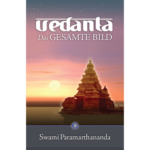Satsang with Ben de Silva
It all depends on your point of view.
For the non-advaitin, the dvaitin, the dualist.
There are forces in Nature which can be personified, eg. St Francis of Assisi called the sun ‘brother’ and the moon ‘sister’, etc. In the Hindu tradition too, there is personification or anthropomorphism, thinking of and calling the forces in Nature by name, both masculine and feminine. All forms in creation are bound by, affected by these forces and it is wise to recognise and acknowledge them.
For example, knowledge is masculinised as Brahmaji, the Creator, since knowledge is required to create. The power ‘behind’ that knowledge is feminised and called Sarasvati, the goddess of knowledge, language, sciences. To maintain creation, material abundance is needed. The maintenance aspect is masculinised as Vishnu while the power to maintain is Lakshmi, the goddess of wealth, abundance, prosperity. At the time of the ‘Big Crunch’ when the universe, once again, returns to its potential state, the one who causes the process of un-manifestation is masculinised as Shiva while the force doing it is feminised and feared as Kali.
All forces in Nature are feminised and generalised as powers or ‘shakti’. The power of the wind is ‘shakti’. The power of water to generate electricity or be the force of a tsunami is ‘shakti’. So, there is a general use of the word ‘shakti’. Then, according to context, there can also be a particularised use of ‘shakti’ as in the examples above, allowing each person their preference and inclination for the object of their devotion.
For the Advaitin, the non-dualist
All there is, is Consciousness, the one, non-dual, absolute, unchanging Reality, called in Sanskrit, satyam. The word ‘real’ means that which is always present and never changes. Only Consciousness fits that criterion. This Consciousness can manifest as the powers, principles, laws governing all of creation and as all forms.
There is no separation between Consciousness and the form. For example, there is no separation between gold and ring; the perceived difference is only in appearance, not in reality. So, the Advaitin focusses on Consciousness, one’s true inner nature and enjoys the benefits of that recognition. The preference of the Advaitin is on Consciousness rather than on the forces or powers, ‘shakti’.
But as living beings, we continue to be a combination of Consciousness and matter. The Advaitin acknowledges the presence and experience of different forms of matter, eg. one form being ‘shakti’. All the different types of ‘shakti’ are in the realm of matter. Like all matter, ‘shakti’ is a seeming reality, a relative and dependent presence, a transient appearance from Consciousness, called in Sanskrit, mithya. For the Advaitin, this means that ‘shakti’ is like a mirage, a phenomenon which is present, can be experienced but is not real, not absolute Reality. Or, it is like ring which is a temporary and experienceable form of gold but the ring itself is not real, not independently existent. Like ‘shakti’, it is mithya.
The Advaitin knows/cognises that ‘shakti’ is really Consciousness temporarily manifesting as that ‘shakti’. There is no separation or difference between Consciousness and ‘shakti’ just as there is no separation or difference between gold and ring. The seeming difference is only in appearance.
By contrast, the non-Advaitin, the dualist, accepts and relates to only one aspect, that of matter, including ‘shakti’, and is not aware of Consciousness, one’s true inner nature. The dualist takes ‘shakti’ to be real, which it is not, and worships it as such. The dualist does not know that ‘shakti’ is only another manifestation of Consciousness.
So, the Advaitin is free. The Advaitin, as a living being, is free to acknowledge and honour ‘shakti’, both generalised and particularised. The Advaitin is also free to continue focussing on his/her true nature of Consciousness and enjoy the benefits of such a recognition. He is also free to relate to ‘shakti’ if he/she so chooses. This is how Advaita, non-duality, really frees. It is true inner freedom. Or to quote Hamlet in the context of Vedanta, the Advaitin is free: “To be, or not to be” !!!!











